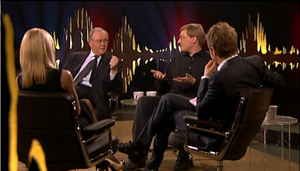January 26, 2009
The array from the pole
 Practical Ethics: Polar exploration: small steps towards cheaper, safer, easier IVF?
Practical Ethics: Polar exploration: small steps towards cheaper, safer, easier IVF?
This little piece is about the new method of analysing the DNA of the polar body of the egg for chromosomal abnormalities using an array microanalysis in order to only fertilize eggs without abnormalities. If it works as it should it would improve reliability (and hence lower cost, effort and twinning) for IVF and reduce production of excess embryos. Generally good.
I'm only human. And so is science.
 Michael Brooks writes in The Guardian Black holes in the argument: Real-world science is messy and inconclusive. The article was likely triggered by the New Scientist article based on our article.
Michael Brooks writes in The Guardian Black holes in the argument: Real-world science is messy and inconclusive. The article was likely triggered by the New Scientist article based on our article.
It is a nice piece on the messiness of real science, but it stumbles in a very telling way at the end: it claims that when the stakes are high we should trust experiments than theory (which sometimes is true). But then it brings up the cosmic ray argument as conclusive for LHC safety. That really shows that he haven't read our paper, where we review how the argument have had to be updated at least twice to deal with pretty subtle flaws. It still remains the main reason I sleep easily at night, but there is far more complexity to it than people tend to allow for (moving frames and slowdown, anthropic corrections).
Of course, not reading the papers one is citing or arguing from is pretty common. It happens all the time in science and blogging too. We rely to an amazing degree on surface information, skimmed impressions and inferred contents. Very human, not always wrong, but risky. One should increase one's intellectual due dilligence proportional to the stakes of the claims.
January 23, 2009
The audacity of safety
 Seems our paper is in the news again: How do we know the LHC really is safe? in New Scientist. They seem to get our argument right.
Seems our paper is in the news again: How do we know the LHC really is safe? in New Scientist. They seem to get our argument right.
It is especially fun that NS writes about it right now since this paper just arrived on arXiv. It shows that under some warped brane world theories (i.e. very speculative physics we have no evidence for) black holes can evaporate much more slowly than expected. It also shows that they still won't have the chance to grow dangerously in Earth (and all the previous cosmic ray arguments, Dar's supernova argument and Mangano's argument about dense stars also hold, of course). Not that that is going to calm the usual suspects or sensationalist journalists. But it does demonstrate how hard it is to make a "rock solid" argument.
What surprisingly many people seem to have trouble with is the idea that one can speak of the probability that a theory is correct. Yes, presumably there is a true mechanism of quantum gravity out there and any particular theory we make is either right or wrong. But that is a bit like saying that there is a true winning lottery number out there, and tickets are either winners or losers. What we usually care about is the fraction of winning versus losing tickets. In the case of theories we are also more interested in how many of them are adequate for reaching a certain conclusion. Also, what our paper deals with is the probability of arguments being correct, which not just includes the chance of the underlying theory being adequate but also that calculations are correct etc. This is something we can actually put bounds on based on past experience, and hence get a rough estimate of how certain we should be about our arguments.
We actually estimate the likelihood of arguments being right every day. When somebody claims we should do this because of that, we adjust ourselves based on how plausible the argument sounds and the past reliability of the person. It is not different in science or when dealing with global disasters. It is just that we get unusually high sensitivity to uncertainty when probabilities are extremely low and stakes high. However, public reactions to LHC safety arguments show that other cognitive biases can easily overshadow the rational concerns.
Approximately 1.2 billion years from now, in a galaxy 20,000,000 light-years from the Milky Way
 As I was working on a talk I will give next week, I came across Mortal Passage by Localroger. This is a story that is part of a much bigger epic, Passages consisting of a number of interlinked short stories. They stretch over 1.2523 billion years and a couple of galaxies. I'm pretty reminded of Alastair Reynolds (especially Galactic North).
As I was working on a talk I will give next week, I came across Mortal Passage by Localroger. This is a story that is part of a much bigger epic, Passages consisting of a number of interlinked short stories. They stretch over 1.2523 billion years and a couple of galaxies. I'm pretty reminded of Alastair Reynolds (especially Galactic North).
The setting is interesting because it deliberately does not assume many standard sf assumptions: assuming the rare earth hypothesis, no FTL , maximum travel speeds around 2-4% c, and that superintelligent and/or friendly AI is likely impossible, it still manages to be a post (?) human epic. I'm somewhat sceptical of the slow development timescale of the upload economy (and why just one upload once the technology works?), which reminds me of Stapledon's 50,000 year timescale for developing spaceflight (by a united and extra smart human species). Another somewhat grating thing is the terrestrial climate disaster, where it seems that some entities must have been almost criminally negligent or incompetent not to plan for these eventualities. Maybe that is the price of not having "true" superintelligence, just a lot of intelligence - I have the feeling that the different Bringers are pretty uncreative (part of this might be intentional, with the occasional references to weird new ideas only biological humans can come up with). But it seems that even a bunch of plodding AIs would think a bit about security and emergency plans when attempting big projects near sensitive natural resources.
I think the Mortal Passage story is interesting because it deals with a brain emulation scenario that does not feel totally unlikely - I am a fan of the microtome procedure, the early and ongoing problems with setting up a good sensory reality and the many possible jobs for a virtual human. The brain editing is handled low-key but is of course the most speculative part. It is one thing to do a memory erasure, since that is likely not too different from induced reconsolidation. It is much harder to imagine how to edit a human mind to just be concerned with flying and navigation. But neuroscience is going to move fast once uploads exist - assuming we can figure out how to do ethical experiments on them. Even if a software person consented to radical experiments it is unclear whether resulting failures wouldn't have a pretty strong claim to life. The behaviour of the researchers at the start of the story is also somewhat problematic, although I can imagine medical ethics justifications for most of what they do.
 The issue of death is another aspect of the story which I find curious. There is a hint of deathism (the idea that death is good) but at the same time it is clear that there are many extremely long-lived entities around that are perfectly happy. Many of the Bringers demonstrate an equanimity towards survival that looks positively machine-like, but also makes sense in a world of copyable minds with relatively similar contents. Maybe it is the similar contents assumption that is the problem. How quickly uploads would diverge seems to be a crucial question, but it can likely not be answered before we have at least some animal emulations.
The issue of death is another aspect of the story which I find curious. There is a hint of deathism (the idea that death is good) but at the same time it is clear that there are many extremely long-lived entities around that are perfectly happy. Many of the Bringers demonstrate an equanimity towards survival that looks positively machine-like, but also makes sense in a world of copyable minds with relatively similar contents. Maybe it is the similar contents assumption that is the problem. How quickly uploads would diverge seems to be a crucial question, but it can likely not be answered before we have at least some animal emulations.
It could be that clades derived from single humans (or clades derived from humans with the right values, or even clades selected for it) might develop a group altruism that trumps normal survival-selfishness. It is intriguing to consider Hamilton's rule for when kin selection occurs could apply in a clade of minds. Relatedness would depend on similarity of ideas, and reproduction would correspond to what minds get copied. Since the reproductive costs could probably be reduced to near zero, maybe extreme clade-altruism is to be expected? So following Haldane, I should be willing to lay down my life for 1.1 copies of me.
January 22, 2009
Debundling Enhancement
 This monday I gave a presentation at the Triple Helix event Cognitive Enhancement: Hope or Dope? with professors Barbara Sahakian and Michael Langford.
This monday I gave a presentation at the Triple Helix event Cognitive Enhancement: Hope or Dope? with professors Barbara Sahakian and Michael Langford.
Langford, not being part of the enhancement debate business, made a very nice presentation where he pointed out that in many cases religious and secular views (and for that matter, different ethical views) tend to reach the same conclusions in the vast majority of issues. There is a pretty broad shared rationality. His main concern was that "enhancement" has a normative content, and we might be imposing that normative content without thinking when we enhance. I think there is a great deal of truth to that, but it is not an indictment of enhancement but rather to do it uncritically.
The problem is that doing "critical enhancement" requires a lot of work: knowing what the enhancer does, how it fits my lifestyle and biology, seeing the context and so on. Most people do not have the time or interest to figure that out, they just want to become "better". So it is likely that we will be seeing enhancements packaged into suitable bundles that also carry assumptions and biases it might be hard to get away from. This is of course similar to any other technology: iphones, linux installations, model railroads or SUVs all come with bundled assumptions. This is why we need open standards: so that people who want to debundle technologies to fit their choices and goals have a chance of doing it.
The problem might be that the broad shared rationality across a culture provides a biased backdrop that makes even open standards produce biased results: very few people deviate strongly from the shared rationality. This is why it might be extremely fruitful to look at how enhancers (or other technology) is used across cultures, especially if it is misused from the perspective of one culture.
January 18, 2009
Why was the Briggate crossing controversial?
 I love specialized studies, be they of interesting parking lots or the tadpoles of south-east Australia (both books found in my library). Thanks to Design with Intent I came across CBRD: Pedestrian Crossings - a great history of UK pedestrian crossings, complete with flash simulations (including both the 1980 and 1985 version of the flashing amber arrow crossing) and the often bizarre administrative background.
I love specialized studies, be they of interesting parking lots or the tadpoles of south-east Australia (both books found in my library). Thanks to Design with Intent I came across CBRD: Pedestrian Crossings - a great history of UK pedestrian crossings, complete with flash simulations (including both the 1980 and 1985 version of the flashing amber arrow crossing) and the often bizarre administrative background.
Overall, the whole CBRD site is full of amusing details about the British road network - the names for the interchange types, details for the Magic Roundabout of Swindon (yes, that is its official name now) and the epic (and failed) London ringway project 1940-1970. There are also links to equally intriguing sites, such as The Idiots' Guide to Highways Maintenance and Pathetic Motorways. The only one lacking is my old favourite www.motorwaysteps.co.uk, now sadly defunct (see the wayback machine).
Not being a driver, I yet find the study of odology fascinating.
January 17, 2009
Me and Skavlan
 This week I was interviewed on Swedish television by Fredrik Skavlan. The program can be seen on SVT Play (search for Skavlan, it is the 090116 program; I occur about 19 minutes in). I talked about life extension and cryonics with Skavlan, Åsa Vilbäck ("Dr Åsa", doctor and media personality), Göran Persson (former prime minister, currently philosophical farmer) and Anitra Steen (manager of the state liquor monopoly and married to Göran - a very sharp lady). It was a rather relaxed discussion, and we seemed to agree that aiming for longer and healthier lives is a good thing, and that of course people should be allowed to pursue it freely.
This week I was interviewed on Swedish television by Fredrik Skavlan. The program can be seen on SVT Play (search for Skavlan, it is the 090116 program; I occur about 19 minutes in). I talked about life extension and cryonics with Skavlan, Åsa Vilbäck ("Dr Åsa", doctor and media personality), Göran Persson (former prime minister, currently philosophical farmer) and Anitra Steen (manager of the state liquor monopoly and married to Göran - a very sharp lady). It was a rather relaxed discussion, and we seemed to agree that aiming for longer and healthier lives is a good thing, and that of course people should be allowed to pursue it freely.
My grandmother lost the debate within the family about whether I should unbutton my shirt or not. And I'm now "out" as a cryonics person in Sweden (to nobody's surprise, I guess).
January 15, 2009
Unlawful spaces of identity
 I went to the Max Ernst exhibition at the Stockholm Museum of Modern Art, where I saw this nice dadaist formula for competition. So now we know that the square root of Juno is larger than the sine of the corset angles times the logarithm of R&H to the power of dada.
I went to the Max Ernst exhibition at the Stockholm Museum of Modern Art, where I saw this nice dadaist formula for competition. So now we know that the square root of Juno is larger than the sine of the corset angles times the logarithm of R&H to the power of dada.
I quite like Max Ernst's decalomania works from the 40's. Giornale Neuvo has a nice post about it, including the heart-warming episode of how it helped him escape France during the war.
To me these paintings have always seemed wonderfully Lovecraftian. This is Rlyeh in tropical sunshine, with the baroque coral architecture of the Great Old Ones clearly visible. I wonder why some find it uncanny. Maybe it is because it is so unlike human objects, but we generally do not find fractal nature uncanny.
While I enjoyed the decalomania the most, it was also interesting to see the sheer range of styles Ernst had gone through. From dada to classic surrealism, to collages to abstraction. As well as Kermit-like sculptures and the Codex Seraphinianus-like work "Maximiliana: The illegal practice of astronomy" written in an invented alphabet.
This links the exhibition in my mind to Philip Palmer's space opera Debatable Space. While the main plot deals with a group of space pirates attempt to unseat the evil dictator of humanity (as you can guess, almost all reviews include the word 'swashbuckling'), the truly interesting part is the recollections of one of the characters, Lena. She happens to be the oldest living human. She was born in the late 20th century and lucky and driven enough to get the right rejuvenation methods. Her story, told from her rather conceited viewpoint, is in my opinion the redeeming feature of an otherwise pretty simple story with standard plots, caricature evil and Xanathos roulettes.
What I find interesting with Lena's story is the serious attempt at sketching just how varied an extremely long life would be. From Oxford academic to crime-fighter to self-help guru to dominatrix to failed actress to NGO manager to relief worker to politician to criminal to archivist to nobility to space loner to pirate... The many lives of Lena suggest that a sufficiently long life might be equivalent to many lives. Except that there might be a few more or less random things ending up being the personal core. Maybe there isn't so much a self as a persistent style - but this style might again be expressed in many different ways.
We will hopefully see in the future just how much we change across life. My guess is that a merely unageing human would get stuck in a certain personality and style rather easily. But true longevity is going to require adaptation and change on a deep level, and this might force us to change more (keeping the brain's learning rate and hence changing rate from declining seems to be necessary, for example). The question is whether indefinite survival requires so much change that identity is not preserved. In a cultural setting change comes from coevolution with other ("culture" in its broadest sense) people and technological change. Since culture cannot be arbitrarily divergent since it is tied to inter-person relations, I don't think culture is going to be the main threat to identity. But technological shifts (like updating to a postbiological state) might be more threatening to identity. But maybe that is just because we are not used to them happening all the time.
January 02, 2009
Good forensics make good neighbors?
 It is dangerous to leave traces...
It is dangerous to leave traces...
I found this sign in a friend's apartment complex, threatening whoever is spitting in the elevator with DNA fingerprinting. It is a weird mixture of nosy/annoyed neighbors and CSI.
DNA fingerprinting is a bit too expensive today for neighbors to do, but that is going to change. Do we want it to happen? It is not entirely clear it can be prevented. Although laws may forbid it and it might not be usable in court, once it is cheap and easy to identify DNA samples nosy people will do it. The main use would be within the local social network rather than in any formal sense - being able to prove that a certain person known to the neighborhood has behaved badly can have a real effect on behavior.
The main challenge would be to get a reference sample from people. This is where neighbors might actually refuse on privacy grounds - but the social pressures of cooperating would also be strong.
If neighborhood DNA fingerprinting appears science fictional, consider the increasing availability of surveillance cameras (it is easy to put a webcamera in one's window) or even fingerprint collection.
The difference from the old world of having nosy neighbors that saw what was going on and enforced consensus behavior is that modern technology can extend their reach. This is not always a bad thing: making people spit less in public spaces is pretty OK. As urbanization makes us live within more anonymous communities technologically augmented nosiness actually could help keep the community norms together better. The downside is 1) over-reach, where neighbors get intrusive in private areas and 2) enforcement of particular norms that are not the community norms, just certain individual's. One can imagine a bigoted neighbor using technology to detect and socially punish swearing or what they consider inappropriate love.
The real way of preventing excessive nosiness is to push back. The technology is hard to stop or detect, but inappropriate social use is easily detectable (since the neighbor will have to tell others). If technologically augmented social pressure is accepted, then it will be used. But if the response to such pressure is indignation and increased surveillance of the nosy neighbor (demanding transparency and equal moral standards) it will be inhibited. In a real community there will be a negotiation about the standards used.
The risk is that anonymous urban communities allow surveillance and some social pressure (like announcing who broke a social rule) without negotiating the social standards. This seems to be the crucial problem, not the existence of surveillance. If communication only occurs through notes in the elevator it will be hard to agree on what is appropriate behavior.
